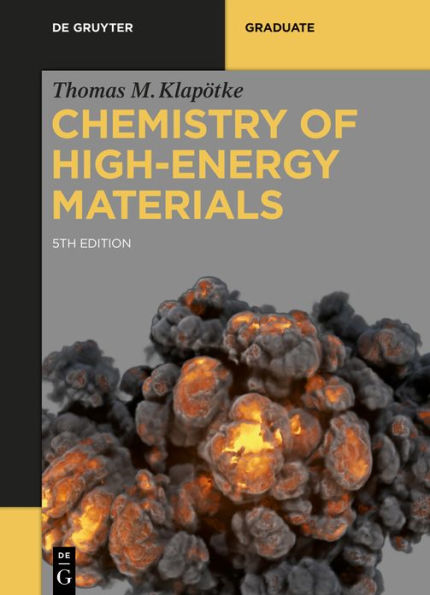Table of Contents
Preface to this 5th English edition vii
Preface to the 4th English edition viii
Preface to the 3rd English edition ix
Preface to the 2nd English edition x
Preface to the first English edition xi
Preface to the first German edition xii
1 Introduction 1
1.1 Historical Overview 1
1.2 New Developments 11
1.2.1 Polymer-Bonded Explosives 11
1.2.2 New High (Secondary) Explosives 15
1.2.3 New Primary Explosives 25
1.2.4 New Oxidizers for Solid Rocket Motors 35
1.2.5 Initial Characterization of New Energetic Materials 41
1.3 Definitions 42
1.4 Combustion, Deflagration, Detonation - A Short Introduction 49
1.4.1 Fire and Combustion 49
1.4.2 Deflagration and Detonation 51
2 Classification of Energetic Materials 55
2.1 Primary Explosives 55
2.2 High (Secondary) Explosives 60
2.3 Propellant Charges 69
2.4 Rocket Propellants 72
2.4.1 Chemical Thermal Propulsion (CTP) 89
2.5 Pyrotechnics 91
2.5.1 Detonators, Initiators, Delay Compositions and Heat-Generating Pyrotechnics 91
2.5.2 Light-Generating Pyrotechnics 95
2.5.3 Decoy Flares 104
2.5.4 Smoke Munitions 111
2.5.5 Near-Infrared (NIR) Compositions 122
3 Detonation, Detonation Velocity and Detonation Pressure 125
4 Thermodynamics 137
4.1 Theoretical Basis 137
4.2 Computational Methods 143
4.2.1 Thermodynamics 143
4.2.2 Detonation Parameters 147
4.2.3 Combustion Parameters 151
4.2.4 Example: Theoretical Evaluation of New Solid Rocket Propellants 160
4.2.5 Example: EXPL05 Calculation of the Gun Propellant Properties of Single, Double and Triple Base Propellants 167
4.2.6 Semiempirical Calculations (EMDB) 169
5 Initiation 173
5.1 Introduction 173
5.2 Ignition and initiation of Energetic Materials 175
5.3 Laser Ignition and Initiation 177
5.4 Electric Detonators 183
6 Experimental Characterization of Explosives 187
6.1 Sensitivities 187
6.2 Long-Term Stabilities 214
6.3 Insensitive Munitions 216
6.4 Gap Test 217
6.5 Classification 218
6.6 Trauzl Test 220
6.7 Aging of Energetic Materials 223
7 Special Aspects of Explosives 235
7.1 Shaped Charges 235
7.2 Detonation Velocities 244
7.3 Gurney Model 250
7.3.1 Example: Calculation of the Gurney Velocity for a General Purpose Bomb 255
7.4 Plate Dent Tests vs. Fragment Velocities 256
7.5 Underwater explosions 262
8 Correlation between the Electrostatic Potential and the Impact Sensitivity 269
8.1 Electrostatic Potentials 269
8.2 Volume-Based Sensitivities 272
9 Design of Novel Energetic Materials 275
9.1 Classification 275
9.2 Polynitrogen Compounds 277
9.3 High-Nitrogen Compounds 283
9.3.1 Tetrazole and Dinitramide Chemistry 284
9.3.2 Tetrazole, Tetrazine and Trinitroethyl Chemistry 291
9.3.3 Ionic Liquids 296
9.4 Dinitroguanidine Derivatives 300
9.5 Co-Crystallization 302
9.6 Future Energetics 303
9.7 Detonation Velocities from Laser-induced Air Shock 317
9.8 Thermally Stable Explosives 323
10 Synthesis of Energetic Materials 331
10.1 Molecular Building Blocks 331
10.2 Nitration Reactions 332
10.3 Processing 337
10.4 Safe Handling of Spent Acid 338
11 Safe Handling of Energetic Materials in the Laboratory 343
11.1 General 343
11.2 Protective Equipment 344
11.3 Laboratory Equipment 347
12 Energetic Materials of the Future 349
13 Related Topics 357
13.1 Thermobaric Weapons 357
13.2 Agent Defeat Weapons 360
13.3 Nanothermites 362
13.3.1 Example: Iron Oxide/Aluminum Thermite 369
13.3.2 Example: Copper Oxide/Aluminum Thermite 370
13.3.3 Example: Molybdenum Trioxide/Aluminum Thermite 371
13.4 Homemade Explosives 371
13.5 Explosive Welding 372
13.6 Gas Generators (Air Bags) 373
13.7 Toxicity Measurements 376
14 Study Questions 381
15 Literature 385
16 Appendix 397
Important reaction types in organic nitrogen chemistry 397
Curing of a diol (HTPB) with isocyanate binder 401
Important reaction types in inorganic nitrogen chemistry 401
Collection of formulas 411
Author 417
Index 419




